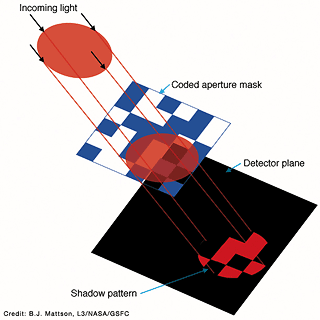Schematic of a coded aperture telescope: Incoming light hits the coded aperture mask, casting a shadow on the detector. The position in the sky of the source may be inferred from the location of the shadow on the detector.
Credit: B.J. Mattson, L3/NASA/Goddard Space Flight Center
The trouble with gamma rays is that they just go right through mirrors, so historically we could not image the gamma-ray sky with mirror telescopes. Another technique called coded-aperture imaging was developed. In the 1990s and 2000s, virtually every gamma-ray instrument that’s flown uses this coded-aperture technique.
In a coded-aperture-based telescope, there’s a “mask” mounted above the detectors at a distance of about 1m that has small lead tiles glued to it in a known pattern. There are also open areas on the mask. Gamma rays hitting the lead tiles are stopped, but those going through the open areas continue on. We measure the pattern of gamma rays at the detector plane, and then use a computer to deconvolve, or isolate, the patterns. This can tell us the location of the gamma-ray source in the sky.
The advantage of a coded-aperture telescope is that it can observe a broad patch of sky. So if we want to view a lot of sky at once, a coded-aperture-based system is best. But it’s more complicated and not as sensitive as a focusing system would be. Until recently there was no technology for focusing gamma rays, but that’s changing now, at least for the "low energy" part of the gamma-ray range with energies just above the X-ray band, so-called "hard X-rays."


